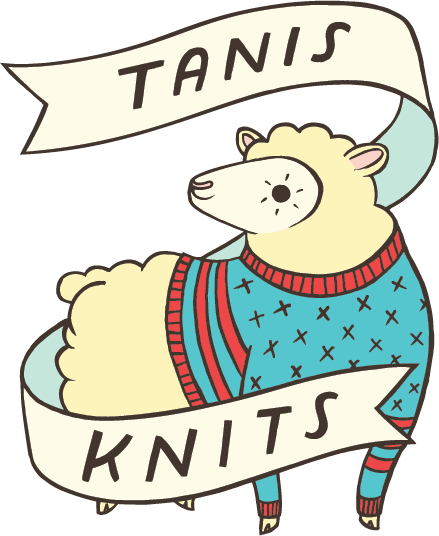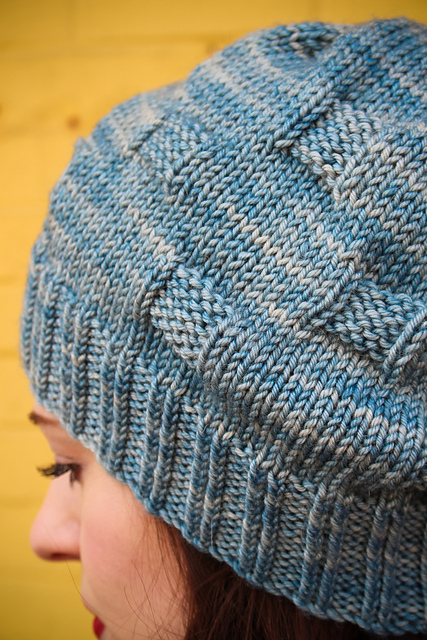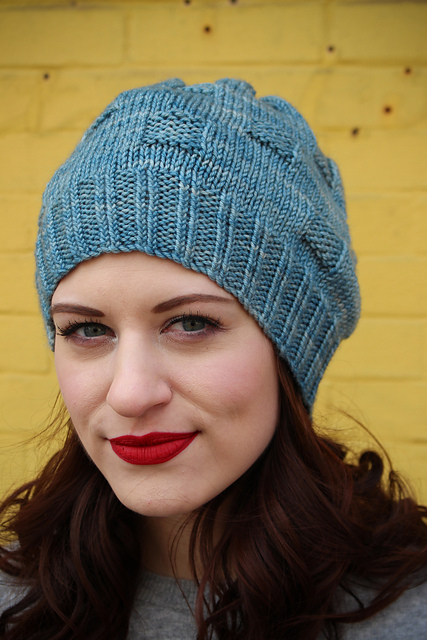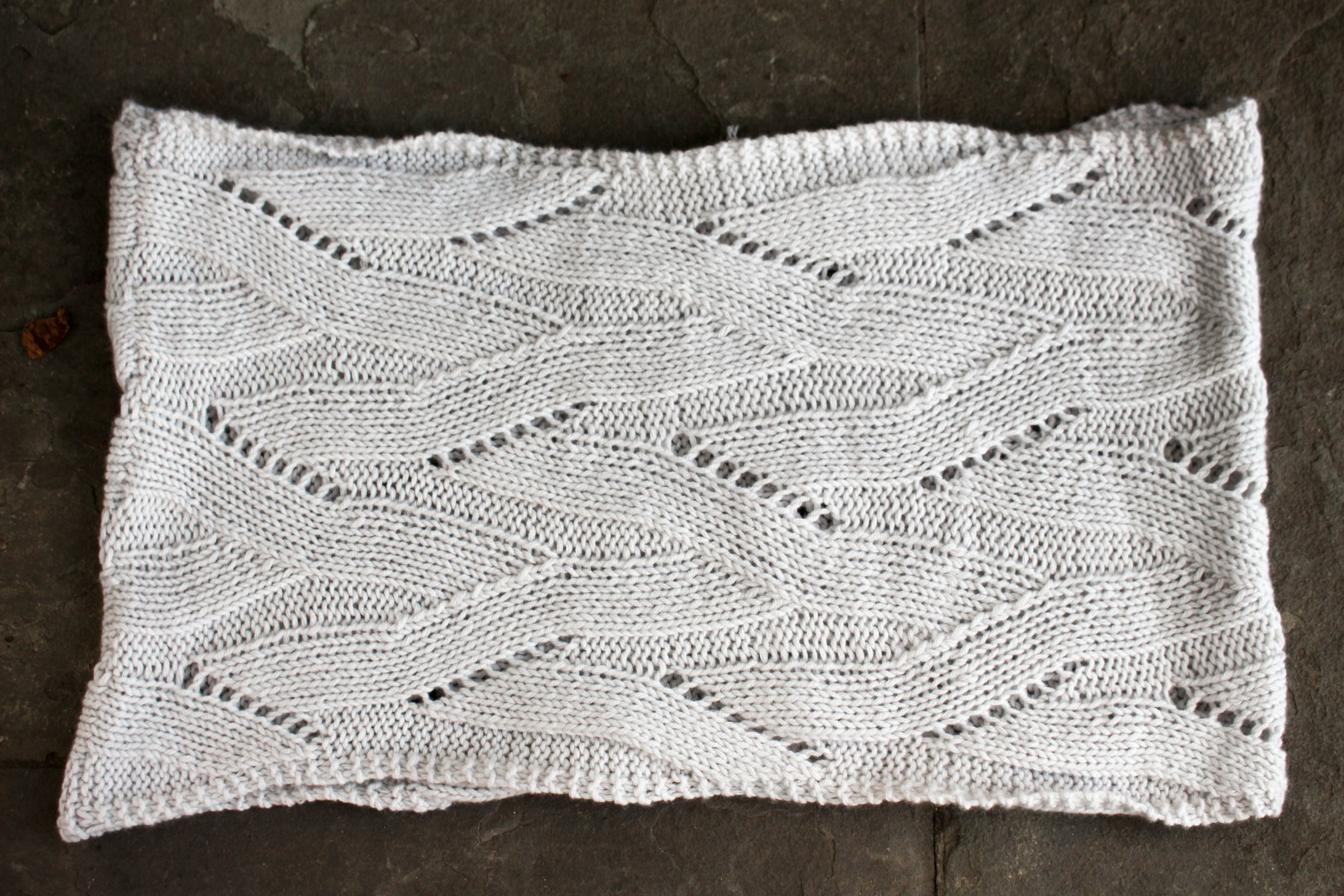UPDATE: 2.5.16: Congratulations to winner Heather! Heather, check your email.
----------
Lars Rains is known for his amazing Fair Isle work. In his new book, Modern Lopi: One: New Approaches to an Icelandic Classic, he creates patterns tailored to today’s lifestyle, celebrating bold, creative palettes. Lars draws inspiration from twentieth-century music, Icelandic mythology, mathematical concepts and drunken bar crawls to craft an innovative collection that explores new and exciting possibilities for this traditional yarn.
Lars was kind enough to sit does with me and answer some questions about his new book.

Tanis Gray (TG): I love that you took a classic technique and design and made it modern! How did you come up with your idea for the book?
Lars Rains (LR): I’ve been knitting with Icelandic wool for over twenty years. Every year, I would eagerly anticipate the new book of Lopi patterns from Ístex, the company that produces the yarn. The sweaters in those books generally had traditional designs with a limited range of color schemes. I thought that it would be fun to combine different silhouettes with unusual color choices in order to introduce my own aesthetic to the world and to explore the many different ways this yarn could be used.

TG: Like you, I was thrown into a fair isle sweater pretty soon after learning how to knit! I was just a kid and didn’t know stranded color work sweaters “should be scary.” I was always thankful that I was chucked into the deep end right away. Do you feel the same way?
LR: I think every knitter has some type of project that he or she may find daunting. I know that I never attempted socks for over ten years because I was afraid of those tiny needles after learning how to knit with bulky yarn. In fact, I had never worked an ssk before that! I also had an irrational fear of lace, but now I love designing openwork shawls and garments. This is why I firmly believe that everyone should learn a new technique or skill with each new project. It’s only scary the first time you do it.
TG: Agreed! You’ve organized your book according to weight. Some people think Icelandic wool only comes in one weight. Was this to educate people on the possibilities?
LR: Absolutely! Lopi is available in North America in four different weights and each of them has its own benefits and drawbacks. Bulky Lopi is actually a super bulky yarn and it is perfect for quick accessories, so I came up with a scarf pattern and a shawl design with it for my book. Álafosslopi is the yarn that most people are familiar with here and it is the traditional yarn used for Icelandic sweaters or lopapeysur. Léttlopi is the worsted alternative and it has quickly become my new favorite for when I want to design a garment with a lot of drape and loft in it. Finally, there is Einband, which is the laceweight version. I can see myself using it a lot more in the future, as it comes in an extensive color palette and it works up to a DK weight when held double. It lends itself well to detailed color work, like in my Monsina sweater.
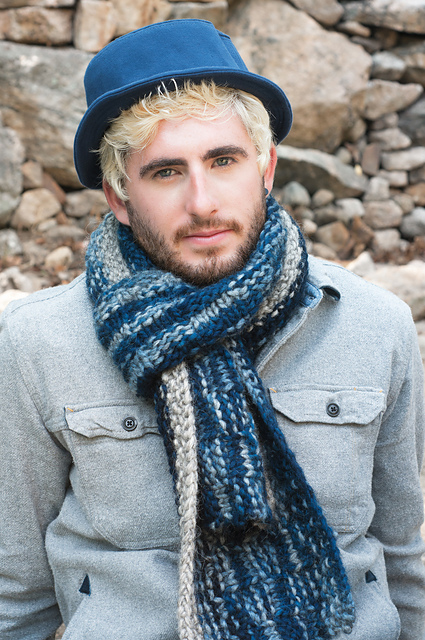
TG: Have you been to Iceland? What about this particular style of knitting inspires you?
LR: I had the chance to go to Iceland in the summer of 2012 and I can’t wait to go back. The capital, Reykjavík, has such a vibrant art scene and everybody wears Icelandic sweaters. You can even buy Lopi yarn at the grocery store! I also spent a couple of days in Ísafjörður, which is in the northwest of the country. It’s a small town built on a little spit of land in the middle of a fjord, bracketed on either side by towering mountain ridges. It is the capital of the Westfjords region and it is, quite simply, the most beautiful place I have ever visited. I would love to retire there some day. Icelanders have a deep affinity for nature and the colors of the landscapes continue to inspire my designs. I also enjoy taking the traditional constructions found in this style of knitting, such as the seamless yoke sweater, and using it as the foundation for more adventurous approaches to design. I like to push the boundaries of what is possible with this yarn and to try new things that other people haven’t thought of yet.
TG: Tell us about your color choosing process.
LR: I like to organize my collections around a unifying principle, like a particular color or technique. In this book, I was obsessed with the Fuchsia Heather and Dark Magenta colors that Ístex produces. There are so many bright colors to choose from with this yarn, but they weren’t often well represented in the more traditional designs. It’s a challenge for me to try to combine vivid colors which really shouldn’t work together, but somehow I manage to find a way to make it work. Recently, I’ve become enchanted with gradient yarns and I’m looking forward to developing some ombré effects for my next Modern Lopi book. I also enjoy limiting myself to monochromatic palettes at times; otherwise, I can get overwhelmed by all of the possibilities.
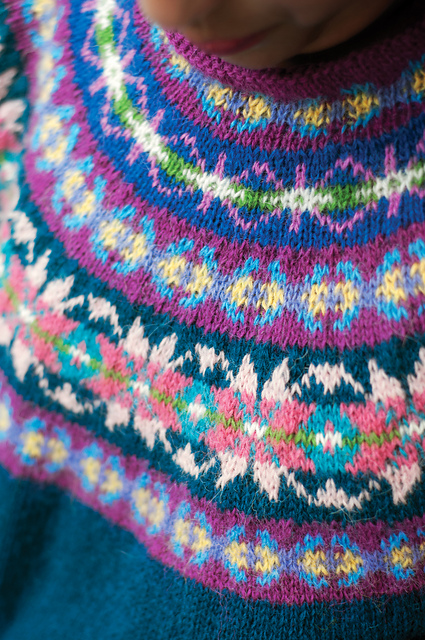
TG: What is your favorite garment in the book and why (mine is Hildur)?
LR: That’s like having to decide who your favorite child is! I like them all for different reasons. Hildur is the perfect blend of the traditional and the modern, with its updated color scheme and gentle waist shaping. However, it’s not my favorite sweater, as it took me about twelve hours to grade it for six different sizes! Rúntur has the best conceptual back story, as you supposedly start knitting it when you are sober and finish it when you are completely drunk. But I think that I would have to go with my cover sweater, Asymptote. It isn’t that hard to stack horizontal bands on top of one another and call it a yoke design. For me, the best Icelandic sweaters have what I like to think of as vertical movement in their yokes and I achieved that for the first time in this sweater. It was very fulfilling for me professionally to have come up with something that could proudly stand alongside sweater designs by Jared Flood, Kate Davies, Ysolda Teague, and Védís Jónsdóttir, the principal designer at Ístex.

TG: I look at fair isle charts the way people look at fashion magazines – they’re so beautiful! Is drawing the charts your favorite part or do you start with the silhouette then do the charts? Tell us about your design process.
LR: I’m glad that I’m not the only designer who likes to go straight to the charts! The written instructions tell me so much about new construction methods, but they often make me fall asleep when I read them. I’m definitely distracted by shiny things and charts are my favorite things to analyze. My design notebooks are absolutely filled with them and I always start my sweater designs with them first. I’ll then make a swatch or two to see how I’ll need to switch up the color arrangements for better contrast and internal coherence. After that, I usually just dive right into my knitting, making adjustments to the silhouette as I go. Designing is a very organic process for me and I often end up at a different destination than the one that I had intended. At the same time, though, I like to have a good idea of what the basic shape of the garment will be and a solid grasp of all of the techniques that I will need in order to achieve my vision before I ever cast on.
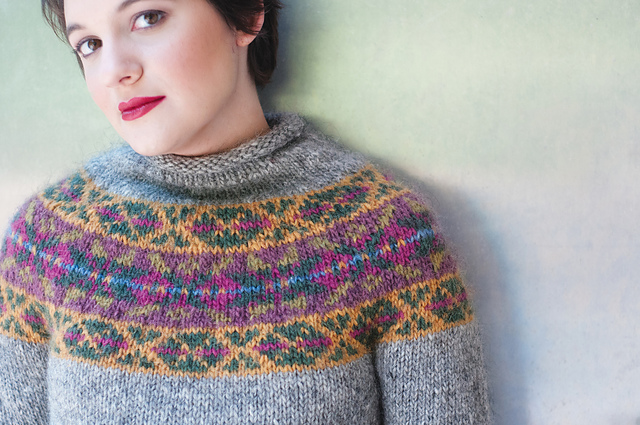
TG: Do you prefer designing accessories or garments and why?
LR: I definitely prefer designing sweaters as I love to have such a large canvas to work with. There is so much more room to play with color and to explore unusual techniques. Sweaters also allow me to expand my toolbox of construction techniques and stitch patterns. Even though I have been knitting for so long and have started designing my own patterns, there is always something new for me to learn, especially when it comes to more feminine silhouettes. I don’t have a lot of experience around women’s clothes! Sweater design is the perfect opportunity for me to develop my skills. I look at accessories as studies for future projects, kind of like how painters approach their larger pieces. They are much more accessible to a larger group of knitters, as not everyone wants to invest the time and money needed for a sweater. Designing accessories has also taught me a lot over the past couple of years about how to edit my larger designs so that I don’t try and say too much as a designer in a single project.
TG: You are a man with many interests and a retired NYPD police office! Tell us how you got into knitwear design and what you enjoy doing when you’re not knitting.
LR: I had a knitting blog back in the early days entitled Does a Bear Knit in the Woods? and I used to hang out with people like Franklin Habit and Carol Sulcoski before they became knitting superstars. I used to design complicated sweaters only for myself, but when I saw their careers take off, I thought about trying to get commercial patterns published as well. Unfortunately, I had no idea how to get started. It took me several years to acquire the confidence I needed to send out submissions to magazines and to discover my voice as a designer. I wanted to take the time to figure out how I wanted to present myself in terms of branding and to think about what types of designs I wanted to send out into the world. Jared Flood has been a huge influence on me in this regard. Most of my spare time is spent learning all I can about expanding my design business and trying to get my backlog of completed projects published. It sometimes feels like I am always working, but I do make sure to relax most nights in front of the television with my husband and our two dogs.

TG: I teach a LOT of Fair Isle classes and people freak out over steeking. Any advice for those looking to try their first steek?
LR: Like I said before, any new technique is going to be scary the first time you try it. Now, it’s totally possible to produce a Fair Isle cardigan by working it flat, knitting and purling back and forth. You never have to learn how to steek if you don’t want to, but steeking just speeds up the whole process. It is always good to have a variety of knitting skills that you can call upon whenever you may need them. However, like with any skill, you need to practice. You were going to knit a gauge swatch anyway to make sure that you ended up with the proper size, right? Just add a couple of purl stitches in the middle of your color work pattern and use this swatch as your testing strip to practice your steeking. I know how unnerving it can be to take a pair of scissors to a garment that you spent weeks working on. Swatches work up much quicker and if you somehow make a mistake, you can just start over with a lot less anguish. Once you have steeked a couple of swatches perfectly, you’ll wonder why you were ever nervous about it in the first place.
TG: You’ve published a lot of great designs. Do you prefer working on books or individual patterns?
LR: Thanks so much! I do like submitting individual patterns for publication, but I don’t think that I’ll ever get used to the tight deadlines. The nice thing about getting projects published in book collections or in such magazines as Vogue Knitting and Knitty is that it forces you to come up with an idea, have it crystallize in your head as a fully formed design, and then get it produced very quickly. There is no time for procrastination or self-doubt to enter into the picture. When you’re self-publishing your own patterns, there is a tendency to let time get away from you. That being said, I loved working on this book and learning all about the publishing process. Taking all the time I needed to accomplish my goals allowed me to visualize the entire collection as a cohesive whole and to come up with a particular look for the book that reflected what I was trying to say with my knitting patterns. I was fortunate to work with a great team of artists on this book, from Gale Zucker and her incredible photos to Elizabeth Green and her amazing layout skills. This book turned out exactly as I envisioned it and I couldn’t be prouder of it.
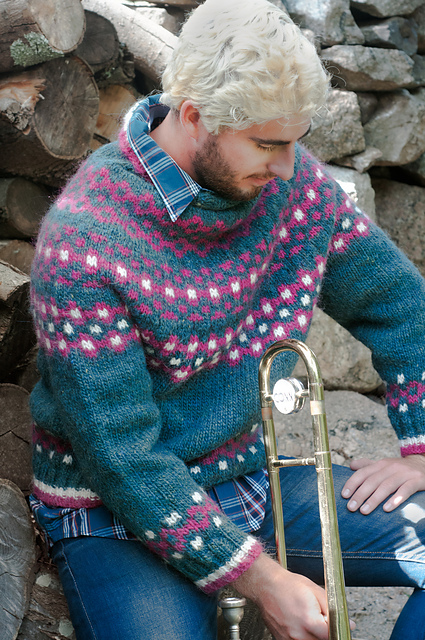
TG: What’s up next for you in your knitting endeavors?
LR: I have been completely overwhelmed by the response to the book and the work that is involved with promoting it! I can’t complain, though, because I am learning so much about marketing along the way. I will be doing a trunk show and book signing at Knitty City in New York City on Saturday, February 6th from 3 to 6 p.m. I will then be headed to Stitches West in California for another book signing and trunk show with Handknitting.com. I have a couple of patterns coming out in future publications and I just received the galleries from the photo shoot for my next book this week. It’s not all work, though. I have a designer retreat in Vermont over the last weekend of February, a men’s retreat in Canada sometime in April, and another men’s retreat in upstate New York in May, so I will get to relax at some point, doing what I love most: knitting.
---------
Thanks, Lars!
Lars has been generous enough to offer up a free PDF of his new book! Answer the below trivia question correctly and automatically be entered in to win.
What is the name of the Icelandic singer who sings La Dolce Vita and what is so fabulous about the Icelandic sweater he is wearing in the video for the song?
Leave your answer in the comments section - a winner will be chosen at random on Friday, February 5. Contest open to readers worldwide.
